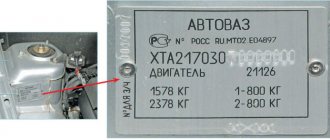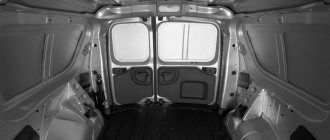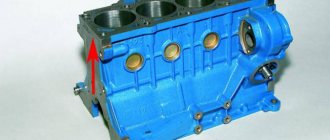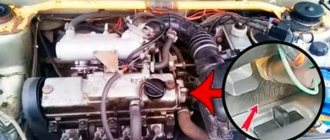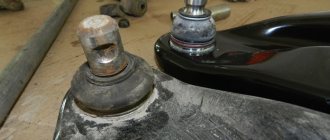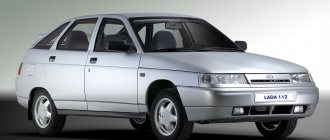Location of unit identification numbers and their designations, VIN number
On the right central pillar, below, there is a double plate with information about the car:
Decoding VIN number
The VIN number is also located (duplicated) under the front passenger seat, on the body cross member
Engine number location
The location of the label depends on the installed engine.
The red arrow indicates the location of the engine number.
Location of numbers on the engine (1.6 l)
This photo shows the engine number with the heat shield removed.
Attention: car enthusiasts note the fact that the location and method of applying the number in this place is unsuccessful. Over 100 thousand km. mileage (in Russian conditions) due to corrosion, this number becomes completely unreadable . This may create problems when re-registering the car. It is recommended that measures be taken to protect this label.
Engine 11189
Engine 21129
Engine K4M
Difference in manufacturer designation
Production AVTOVAZ
Marking of K4M assemblies of AVTOVAZ assembly with the letter “P”
The location of the sticker with the gearbox code can be seen here
Video
Source
VIN code
1. The identification number (VIN) is stamped on the floor under the front passenger seat on the right side. To inspect the room, a valve has been cut out of the carpet. The VIN code is also duplicated on the wall between the engine compartment and the engine.
Depending on the configuration of the Lada XRAY, there may be a glove box under the passenger seat. In this case, to access the number, you must fully extend the movable part of the glove box by pulling the stops outward on both sides.
2. The marking (nameplate) is located on the right pillar, below, near the threshold.
It indicates the model, car number, engine model, weight data, number for spare parts, design options, and configurations. Explanation:
Engine
LADA LARGUS cars are equipped with gasoline, in-line, 4-cylinder, 8- and 16 - valve engines with a displacement of 1.6 liters. with 2 or 4 valves per cylinder.
For engine identification number plate locations, see here. The ratio of installed engines and gearboxes in trim levels can be found here.
Until mid-2016, the car was equipped with Renault K7M (8-cl) and K4M (16-cl) engines. Since 2016, their modern analogues produced by AvtoVAZ began to be installed. Accordingly, the K7M was replaced by the VAZ-11189 , and the K4M was replaced by the VAZ-21129 . The engines are distinguished by a lightweight ShPG, automatic timing belt tensioner, metal cylinder head gasket, body kit and supports.
Since 2022, Lada Largus CNG (with LPG) will be equipped with 21129 CNG dual-fuel engines.
Depending on the vehicle configuration, there are several options for installing auxiliary equipment on engines:
- a car with power steering;
— a car with non-power steering and air conditioning;
— a car with hydraulic power steering;
— a car with hydraulic power steering and air conditioning.
The main parameters and characteristics of the engines are given in tables 1 and 2.
| External delivery Marking of K4M units for external delivery (for example, “D”) | ||
| Options | Engine model | |
| RENAULT, K4M | RENAULT, K7M | |
| Injection type | Electronically controlled multipoint fuel injection | |
| Fuel type | Gasoline Premium-95 GOST 51105-97 | |
| Number and arrangement of cylinders | 4, in-line | |
| Number of valves | 16 | 8 |
| Cylinder operating order | 1-3-4-2 | |
| Direction of rotation of the crankshaft (from the camshaft drive mechanism side) | ||
| right | ||
| Cylinder diameter/piston stroke, mm | 79,5×80,5 | |
| Working volume, cm 3 | 1598 | |
| Compression ratio | 9,8 | 9,5 |
| Toxicity standards | Euro 4 | |
| Power at 5500 rpm, kW (hp) | — | 62 (84) |
| Power at 5750 rpm, kW (hp) | 77(105) | — |
| Maximum torque, N.m (at rpm) | 148 (3750) | 124 (3000) |
| Volume of oil poured into the engine lubrication system, including oil filter, l | 4,8 | 3,3 |
| Options | Engine model | |
| VAZ 11189 | VAZ 21129 | |
| Engine volume, cm3 | 1596 | 1596 |
| Number and arrangement of cylinders | 4, in-line | 4, in-line |
| Number of valves | 8 | 16 |
| Maximum power, kW (min") | 64*(5100) | 78*(5800) |
| Maximum torque, N*m (min*1) | 140*(3800) | 148*(4200) |
| Cylinder diameter, mm | 82 | 82 |
| Piston stroke, mm | 75,6 | 75,6 |
| Compression ratio | 10,3 | 10,45 |
| Injection type | Electronically controlled multipoint fuel injection | |
| Octane number of gasoline | At least 92 | At least 92 |
| Transmission | Mechanical 5-speed | |
| Gearbox designation | JR5, 21809 | |
| Wheel drive | 4×2 | |
| Drive wheels | Front | |
| Environmental class | 5 | |
| Engine weight | ≈111.0 kg | 110.7 kg |
Engine manufactured by AVTOVAZ 1.6 l.
ENGINE 1.6 (8 valve, 84 hp)
The K7M engine is a gasoline, four-stroke, four-cylinder, in-line, eight-valve, overhead camshaft. The operating order of the cylinders is: 1–3–4–2, counting from the flywheel. Power supply system – distributed fuel injection (emission standards Euro 4).
The engine, gearbox and clutch form the power unit - a single unit mounted in the engine compartment on three elastic rubber-metal supports. The right support is attached to the bracket on the top cover of the gas distribution mechanism drive, and the left and rear ones are attached to the gearbox housing. On the front of the engine (in the direction of vehicle movement) there are: exhaust manifold, oil filter, low oil pressure warning sensor, coolant pump supply pipe, spark plugs, generator, power steering pump, air conditioning compressor.
At the rear of the engine there are: an intake manifold with absolute pressure and intake air temperature sensors, a throttle assembly with a throttle position sensor and an idle speed regulator, a fuel rail with injectors, a knock sensor, a starter, and an oil level indicator. On the right is the coolant pump, timing gear and coolant pump drive (toothed belt), auxiliary drive drive (V-ribbed belt). On the left are: flywheel, thermostat, crankshaft position sensor, coolant temperature sensor. On top is the ignition coil, oil filler neck. The engine cylinder block is cast from cast iron, the cylinders are bored directly into the block. At the bottom of the cylinder block there are five crankshaft main bearing supports with removable caps, which are attached to the block with special bolts. The holes in the cylinder block for the bearings are machined with the covers installed, so the covers are not interchangeable and are marked on the outer surface to distinguish them (the covers are counted from the flywheel side). On the end surfaces of the middle support there are sockets for thrust half-rings that prevent axial movement of the crankshaft.
The crankshaft main and connecting rod bearing shells are made of steel, thin-walled, with an anti-friction coating applied to the working surfaces. Crankshaft with five main and four connecting rod journals. The shaft is equipped with four counterweights, integral with it. The counterweights are made on the continuation of the “cheeks” of the engine crankshaft. Counterweights are designed to balance the forces and moments of inertia that arise during the movement of the crank mechanism during engine operation. To supply oil from the main journals to the connecting rods, there are channels made in the journals and cheeks of the shaft. At the front end (toe) of the crankshaft there are installed: an oil pump drive sprocket, a timing gear drive pulley and an auxiliary drive pulley. The toothed pulley is fixed on the shaft with a protrusion that fits into a groove on the toe of the crankshaft and protects the pulley from turning. The auxiliary drive pulley is similarly fixed on the shaft.
The connecting rods are steel, I-section, processed together with the covers. The covers are attached to the connecting rods with special bolts and nuts. The piston pin is steel, tubular in section. The pin, pressed into the upper head of the connecting rod, rotates freely in the piston bosses. The piston is made of aluminum alloy. The piston skirt has a complex shape: barrel-shaped in the longitudinal section, oval in the transverse section. In the upper part of the piston there are three grooves machined for piston rings. The two upper piston rings are compression rings, and the lower one is oil scraper. Compression rings prevent gases from escaping from the cylinder into the engine crankcase and help remove heat from the piston to the cylinder. The oil scraper ring removes excess oil from the cylinder walls as the piston moves.
ENGINE 1.6 (16 valve, 105/102 hp)
The K4M engine is a gasoline, four-stroke, four-cylinder, in-line, sixteen-valve, with two overhead camshafts. The operating order of the cylinders is: 1–3–4–2, counting from the flywheel. Power supply system – distributed fuel injection (emission standards Euro 4). The engine, gearbox and clutch form the power unit - a single unit mounted in the engine compartment on three elastic rubber-metal supports. The right support is attached to the upper cover of the gas distribution mechanism drive, and the left and rear ones are attached to the gearbox housing.
General recommendations for engine maintenance
Note: The information below is for general information purposes only and is not specific to any car brand.
Fortunately, automakers understand that in the world there are not only developed countries like the USA, Germany, Japan, France, etc., but also developing countries like Iran, Nigeria, Angola, Sudan, and now Russia, so cars, those supplied there are often very different from promising technology, and, according to our realities, for the better.
This entire preface was written for a reason. If we are talking today about the health of the engine and its longevity, then the first item on the agenda will, of course, be the choice of the power unit, so that then we can simply carry out scheduled maintenance without any repairs, replacement of components, vessels with warranty departments of dealer organizations and other similar inconveniences that are common drag on for a very long time, especially in our country.
Video
Source
Gearbox malfunctions and methods for eliminating them
Any mechanism has a tensile strength, especially if it operates under variable loads. It is necessary to take into account the driver's driving style, which significantly affects the durability of the part. Summarizing the accumulated experience and analysis of breakdowns that occur during the operation of the car, gearbox faults can be grouped into several main groups: noise in the gearbox, difficulty engaging the gear and spontaneous shutdown of the transmission.
Noise and difficulty shifting gears
The main causes of noise in the gearbox include:
- low oil level;
- water entering the system;
- wear of bearings or gears.
To fix the problem, you should add or replace the oil in the gearbox, replace the bearings and gears with new ones.
Difficulty shifting gears can be caused by the following factors:
- faulty gearbox control rod;
- loosening of fastenings;
- deformation of control drive parts;
- wear of synchronization rings;
- incomplete disengagement of the clutch.
The listed faults can easily be eliminated by adjusting the clutch and replacing deformed and worn parts. It also helps to adjust the mechanisms in accordance with the regulations indicated in the car’s operating manual.
Spontaneous transmission shutdown
The reasons for spontaneous shutdown of the gearbox are usually:
- gear wear;
- damage occurs on the rubber supports of the box;
- wear of the synchronizer rings.
These faults can only be corrected by replacing them with new parts. Do-it-yourself transmission repair requires high qualifications and a set of special tools. Only a competent specialist can remove and disassemble this part correctly.
Where is the VIN number of the Lada Largus?
Many new owners of a domestic station wagon are wondering where the Lada Largus wine is located? Previously, on all VAZ cars, the VIN code was located in the luggage compartment and under the hood. But, LADA Largus is a joint brainchild of the Renault-Nissan-AvtoVAZ alliance, so the VIN number was moved from its usual places.
1. The knocked-out VIN of the Lada Largus is located under the front passenger seat on the transverse floor reinforcement. It’s easy to see – just move the passenger seat as far back as possible. After which you will be able to see a cutout in the carpet through which you can read the VIN code.
2. The VIN number of the Lada Largus is also printed on a duplicate plate on the right central passenger pillar.
What could the code be?
Different manufacturers specify a different number of letters and numbers in engine codes, which makes them completely unique. Domestic manufacturers indicate a code mainly of 6-7 digits.
On foreign cars, the individual code can even consist of 18 characters. The full code was previously indicated in the PTS, so it is important that it completely matches the one applied to the engine.
New Lada: LADA Vesta Sport from RUB 896,310. – Prices and configurations – Official LADA website
If the engine has been reinstalled, it is recommended to carry supporting documents on all trips.
Device and characteristics
The engine marked K4M is a high-tech power unit with high performance. The first production of the power unit began back in 1999. The motor design is quite simple and understandable. The only difference from its younger brother K7M is that there are two camshafts in the cylinder head.
Also, the engine is much quieter because hydraulic compensators are installed. The engine is equipped with sixteen valves, which increases power characteristics and slightly reduces fuel consumption. The average engine life is 350,000 - 400,000 km.
Main technical characteristics of K4M
| Name | Index |
| Manufacturer | Renault |
| Volume | 1.6 liter (1598 cc) |
| Number of cylinders | 4 |
| Number of valves | 16 |
| Fuel | Petrol |
| Injection system | Injector |
| Power | 102 hp |
| Fuel consumption | 7.9 l/100 km |
| Cylinder diameter | 79.5 mm |
| Econorm | Euro 4 |
The French engine was also equipped with gearboxes from Renault cars with JR5 or JH3 markings, which were also installed on Logan.
Service
With normal and timely maintenance, the Largus 16 cl. 1.6 liters can last quite a long time, and to be more precise, up to 500,000 km. According to the manufacturer's standards, as well as service manuals, the engine must undergo scheduled maintenance every 10,000 - 12,000 km, and it does not matter what fuel the power unit is operated on.
Let's consider what operations are provided for during scheduled maintenance of the Largus engine, which has a 16 valve mechanism:
Decoding VIN number Lada Largus
As I wrote above, each Lada Largus VIN number contains encrypted information that can be decrypted. Let's try to decipher the VIN number of the Lada Largus.
For example, we have VIN number XTARSOY5Y5LC0669107. There are 17 characters in the VIN number.
The first 3 characters indicate the code of the plant where the car was produced. This applies not only to Russian production, but also to global production. So in our case it's XTA.
X - geographical area - Europe. T - country - Russian Federation. A - automobile plant - AvtoVAZ.
The fourth character indicates the model's body type. R - passenger station wagon.
The fifth character indicates the project code. S - LOGAN project
The sixth and seventh characters are the Power Unit. OY - K4M engine.
The eighth character is the gearbox type.
The ninth character is the car brand. L - LADA
The tenth character is the year of manufacture of the car.
AvtoVAZ's model year runs from January 1 to June 31 - this is the current year. From 1.07 to 31.12 - next year. If there is a symbol, then it is counted alphabetically, where A-0, B-1, C-2, etc. In our case, C denotes the year of manufacture of the car in 2012.
The remaining seven digits directly indicate the body or chassis number. 0669107
That's basically it. With the help of these instructions you can easily decipher the LADA Largus identification number without any problems.
Interpretation of the duplicate plate on the central pillar of the Lada Largus
In addition to the VIN number, there are also inscriptions on the identification plate. Let's figure out what all these inscriptions mean.
The first line is the plant. In our case, AvtoVAZ. The second line of type E-RU.NT02.B.00338 is the vehicle type. The third line is Vin number (VIN). The fourth line is RMM or permissible maximum vehicle weight - 1790 kg in our case. The fifth line is a RMM with a trailer that has a braking system. In our case, 2650 kg. The sixth line is the maximum load on the front axle of the car. The seventh line is the maximum load on the rear axle of the car.
Short review
On the eve of the spring of 2012, AvtoVAZ released a high-capacity station wagon - Lada Largus. This car is a joint project of the Tolyatti giant AvtoVAZ plant and the French corporation Renault-Nissan Alliance - and, I must say, a very successful one.
To produce the new model, AvtoVAZ workshops were equipped with the latest equipment, and a separate wide full-cycle production base was created. This allowed the use of modern technologies and innovative car assembly lines. As a result, following the pre-production batch of snow-white cars that were not intended for sale, Lada Largus models entered mass production, passed design testing and were available to buyers.
As previously expected by experts, the technical characteristics of the Lada Largus correspond to the status of this, first of all, high-class family car. Key advantages of the new product: spaciousness and reliability, confirmed by a test drive. In general, there are three modifications of the car: and a cargo van.
AvtoVAZ management has already stated that the Lada Largus will not be sold abroad. Basically, the car - which, we note, is maximally adapted to Russian operating conditions - will be sold only in Russia. It will be possible to buy a car through the dealer network of JSC AVTOVAZ, and you can also place an order for the purchase of a car via the Internet.
Production volumes
In February 2012, it is planned to produce more than 600 cars, and further on the rise - in total, about 30,000 new Lada Largus cars will roll off the assembly line in 2012.
As for prices, due to the low cost of car production, it will range from 340 to 420 thousand rubles, depending on the configuration.
Let us remind you that the Lada R90 debuted at the Moscow Motor Show in 2010. The high transformability of the seven-seater cabin allows for a large volume for transporting large and long cargo. In Europe, this car is produced under the Renault brand and is called Logan RF90. The Russian version is adapted to climatic and road conditions.
What engines are installed on Largus: types and characteristics of internal combustion engines
The Russian budget car Lada Largus is built on the VO platform and is the first joint project of the Renault-Nissan alliance and AvtoVAZ. In fact, the car is a copy of the first generation Renault/Dacia Logan MCV station wagon.
Over the years, the car received various internal combustion engines, which have a number of design differences and unique characteristics. Next, we will look at which Largus engine was installed on this model in a given year, as well as what features, advantages and disadvantages different versions of power units have.
Read in this article
Body: dimensions, features
This is a standard passenger station wagon, available in 2 versions: 5- and 7-seater. The body dimensions of the Lada Largus station wagon are as follows (in mm):
With such dimensions, Largus has a simple exterior, essentially repeating the features of the 7-seater Dacia Logan MCV station wagon. It meets the basic ideas of a comfortable, budget car for the whole family - its design is simple, laconic, and devoid of pretentiousness. The control dimensions of the car basically repeat the dimensions of the first generation Renault Logan.
K4M and VAZ-11189 – AUTO-GL.ru
AvtoVAZ several years ago set out to create a good car. A kind of workhorse for the people. Even then, the work of the VAZ-Renault alliance was in full swing. Largus is a direct reflection of teamwork. They developed a car based on Logan. The platform is so successful that the Duster crossover, Sandero hatchback and many Nissan car models are produced on it.
There weren't many changes to Logan to make him Largus. Only the suspension was well redesigned, and the appearance was slightly changed.
Engines for Largus
The body is a body, but the car must be driven by something. The manufacturer did not reinvent the wheel and installed engines from Logan on Largus:
But, there is a domestic development, the engine from Vesta - VAZ 11189. It is also installed on Largus. In fact, this is an engine from Granta, only converted to Euro 5 standards.
We are interested in the last 2 engines: the French one with 16 valves and ours with 8 valves. It’s interesting to know what reviews car enthusiasts write about Largus with a VAZ engine. And of course, compare them with reviews of a foreign-made 16-valve engine.
There is enough information on the network for both engine models. Reviews are also welcome. Experienced owners of Largus are ready to share their opinions and for this you do not need to go through a lot of sites on the Internet. Everything interesting is collected below.
Reviews
Alexander Tatishchev, Yaroslavl, Comparison of Kalina and Largus with a 16-valve engine
I was lucky to be the owner of 2 cars of our production: Kalina 2 with an 8-valve engine and Largus with a new 16-valve engine. Well, like new - borrowed. Therefore, for fun, I decided to compare the 16 valve engine and the Largus with the VAZ engine and write a review about my feelings.
For your information! Kalina is also equipped with a VAZ 11189 engine with 8 valves.
I often drive Kalina fully loaded, since my professional occupation is construction. It happens that she has to carry half a ton. Well, Kalina on the 11189 engine with 8 valves is quite playful. Even when climbing, it is easy to overtake. Our engineers built an excellent 8 valve engine, in my opinion.
Largus will have a greater carrying capacity, but the weight of the car will also be greater. I even did a little tuning, but it doesn't help. The car does not drive stupidly, there is no agility even when empty. Therefore, the K4M engine in the Lada Largus with 16 valves does not deserve the most flattering reviews.
I'm seriously thinking about changing Largus to another car. You can even use Kalina, only newer.
Ivan Kulba, Lada Kalina 2 with VAZ 11189 engine, Nizhny Novgorod
For the last 2 years I have been driving Kalina 2. I live in a rural area, so I carry a lot of cargo, both domestic and for work. In general, the car is always loaded. I did not experience any problems during operation. From time to time it was necessary to adjust the valves at a company service center. Well, standard maintenance. I have driven 20 thousand in 2 years. I know that even if 11189 with 8 valves breaks down, its repair will not be expensive. I use semi-synthetic oil. My neighbor has a Lada Largus with a VAZ 11189 engine and his reviews are not so flattering. Once he let me drive in his empty car. Largus has no dynamics at all. I don’t even know how people tolerate such a dull throttle response. Perhaps the reworking of the engine to the Euro 5 standard had an effect, but the car should not lose so much in dynamics. It’s good that the amount of repairs, if anything, will be the same. But what about the 16 valve Largus? Repairs there will cost a pretty penny.
For your information! Simplicity of design is the main distinguishing feature of the VAZ 11189 engine, compared to a foreign-made 16-valve engine. If the latter breaks down, repairs will be significantly more expensive. True, the French engine is more modern than ours.
Nikolay the Last, Lada Largus 1.6 (105 hp) 2014, Ulyanovsk
In principle, the car is not bad, quite roomy. But there is one unpleasant feature. It’s as if the designers were in cahoots with the oil workers, or the engineers don’t know how to do calculations! The fact is that fuel consumption is 6 liters. 100 km outside the city can only be achieved at a speed of 60 km/h. But will there be anyone willing to plod along at such a snail’s pace? We have damaged roads, but not to the same extent. This car should have such consumption only at 90 km/h. Although the manufacturer claims that the 16-valve engine is economical, this does not turn out to be the case in practice. I don’t know what kind of engine chip tuning the Lada Largus needs to get a positive review. And the dynamics – it’s as if they don’t exist. When the air conditioning is turned on in the summer, the already slow car still loses its dynamics. As for the standard speed of 90 km/h, the engine has 8.5 liters per hundred. No good!
For your information! The air conditioning compressor is driven through a clutch from the engine and can eat up part of its power, which leads to increased fuel consumption.
Alexander Kisly, Lada Largus for 5 seats, 8-valve engine, Astrakhan
A new car is a good purchase. Anything better than an old foreign car. But after it, in my native Lada there are not enough useful little things in the cabin. You adapt to this. In principle, Largus is a good compromise between cost and quality.
As for the review of the Lada Largus VAZ 11189 engine, I am frightened by the high fuel consumption. The data differs somewhat from what the manufacturer claims. At a speed of 130 km/h on the highway, it produces as much as 10 liters per hundred. This is a bit much. But I didn’t load the car to capacity. What happens when it's fully loaded? Regarding the engine, it is worth noting that the 8-valve version is rather weak for Largus. This requires a more powerful motor. But according to rumors, even a 16-valve engine is not enough for dynamic driving.
About the 5th stage. They say that the engine roars on it, but there is no speed. At 3 thousand my tachometer shows a speed of 100 km/h. At 4 thousand - 120 km/h.
For your information! The manufacturer states that on the highway the VAZ 11189 engine with 8 valves should have a consumption of just under 7 liters. In the city 9-10 l. Well, the data is a little different from reality.
Nikita Khrapsky, Lada Largus 2013, engine – 16-valve, Arkhangelsk
I was afraid when buying a car. Still, Lada cars have a bad reputation. But the machine has been serving faithfully in construction projects for 2.5 years. Helps transport cargo, even light ones. I don’t put a lot of load on it, but I don’t pamper the car either.
The 16 valve K4M engine on my Lada Largus deserves a good review, since there were no breakdowns during operation. I haven’t driven it that much – only 43 thousand km. Having read stories about the timing belt, I’m already getting ready to change it. Still, you don’t want to end up with expensive valve repairs because they break. Well, everything is according to my manual. I even always go through the service a little earlier, so that the car does not reach the 2-3 thousand service date. So I warn her against breakdowns. Still, I travel a lot.
As for the dynamics, I'm used to it. Although after the foreign car the first time was not easy. But what can you do - this is how the engineers created this car. All that remains is to use it. It's worth the money.
Ivan Sytko, Lada Largus 2014, 16-valve engine, Novosibirsk
I have had the car for 2 years. Complaints? Domestic. There are shortcomings in many areas, but they are minor, and somehow I’ve already gotten used to it. It’s a sin to criticize a manufacturer who offers a new car for that kind of money, and even his own.
As for the dynamics of the 16 valve engine, Largus has plenty of it in city traffic. In principle, it’s comfortable to drive on the highway, but up to 115 km/h. If you want to go higher, you need to change the 5th gear ratio. 92 gasoline works great for Largus, although the manual says to use 95. But the latter contains a lot of additives - I don’t want to spoil the fuel system and would rather take care of the injectors. Once I filled up with 95 in some remote place, I don’t want to remember it. I don't know how the engine held up. Probably, another person would have already broken down from such vibrations. In general, I cleaned the entire fuel system.
As for the pros:
In general, the consumption hits your wallet a little, you get used to the ergonomics, but otherwise there are no complaints.
Mikhail Prokopyev, Largus 2012 with 16-valve engine, Tambov
I was among the first Largus buyers in the city. I chose the 16 valve version because I needed a powerful and reliable engine. I travel a lot. I work in forestry, so I have to travel long distances.
It’s not a shame to damage a domestic car – it can always be repaired. This quality was adopted by Largus. The engine is good, but lacks traction on the highway. And in the city it’s rather weak. But I rarely go there, so maybe its stiflingness only seems to me. I read the reviews - it doesn’t seem like it.
I changed the timing belt at 60 thousand. But the noise was already heard at 20 thousand. I don’t know how I didn’t get the valves repaired. I was lucky because I read about him later.
Summing up
The presented reviews about the main Largus engines - the 8-valve VAZ 11189 and the foreign 16-valve engine - indicate that for full-fledged dynamics the car needs a slightly more powerful engine. Perhaps the engineers intended a calm and obedient car, but in reality it turned out to be very sluggish.
The weakness of the engines, even the 16-valve version, is evidenced by the fact that they consume fuel a little more than stated. Almost everyone complains about this. For comparison, you can take Kalina 2 from the first review with the same 8-valve engine. According to the user, he walks confidently and dynamically, which Largus lacks.
You can apply tuning to both engines, but this is an additional cost. In addition, the warranty on a new car will be void. It’s easier to buy another car and not have to worry about it. Although some people like to tinker with hardware. The 8-valve engine can be throttled from environmental control, and the 16-valve engine, in general, has wide chip tuning capabilities that allow you to increase the power to 150 hp. With.
What to do if the VIN number of the Lada Largus is damaged?
There are cases when the VIN is damaged when the side pillar is hit during an accident. In European countries, such cars are usually recognized as total vehicles and are no longer driven on public roads. Our car is more likely to be repaired than to go to waste.
If during the inspection at the traffic police the inspector has questions, he will order an examination. If the car is legally clean and the VIN number is legible, then the car will be able to pass verification. If the platform with the identification number is overcooked, then such a car will not be able to pass the number plate verification.
K4M engine structure
The K4M engine of Renault Fluence and other models is distinguished by its simplicity of design and good build quality. The motor operates well under load regardless of ambient temperature.
crank mechanism
The pistons are made of light alloy. To prevent the working mixture from entering the crankcase and oil from entering the cavity of the working cylinder, compression and oil scraper rings are installed on the piston. In the area of the compression rings, the piston is reinforced with a steel insert.
The pistons are connected to the crankshaft by connecting rods. Sliding bearings are installed at the bottom of the connecting rod. They have holes for supplying oil under pressure to the crankshaft journals.
The piston is connected to the connecting rod using a metal pin. It is firmly pressed into the upper hole of the connecting rod.
Gas distribution mechanism
The K4M Renault engine has a 16 V gas distribution mechanism. This means that there are two intake and 2 exhaust valves for each cylinder. The valve mechanism is controlled using two camshafts. Torque is transmitted to the camshafts using a belt from the crankshaft.
IMPORTANT: When the gas distribution mechanism belt breaks, the pistons deform the open valves. To avoid deformation, it is necessary to check the drive belt for damage and, if necessary, replace it.
A distinctive feature of the engine is the different lengths of the valves of the gas distribution mechanism. The intake valves are 1.68 mm longer than the exhaust valves. Thanks to the installed hydraulic compensators, there is no need to adjust the thermal gap.
Cooling
The 16 valve engine of the Lada Largus K4m has a forced-type liquid cooling system. The liquid used in the system is antifreeze or antifreeze. The cooling system is sealed. To avoid leakage as a result of pressure when the power unit heats up, an expansion tank is provided.
For quick warm-up in the winter, a thermostat is included in the cooling system. It blocks a large circulation circle at low coolant temperatures. When the required coolant temperature is reached, the thermostat opens a large circulation circle.
The movement of the working fluid in the cooling system is carried out using a centrifugal water pump. It is driven by a pulley mounted on the engine crankshaft.
A radiator is provided to cool the working fluid. Under the influence of the pump, antifreeze enters the upper radiator tank. After this, the liquid flows through the radiator honeycomb. The antifreeze in the radiator is cooled by air passing through the honeycombs. Forced air movement is carried out by a fan.
Checking the oil level and replacing it in the Largus gearbox
Transmission oil is poured into the Lada Largus gearbox at the factory. Its technical and operational characteristics guarantee uninterrupted operation until the end of the vehicle’s service life. Therefore, it is not necessary to add or change oil in accordance with the operating instructions.
Nevertheless, there is an opinion among car enthusiasts that the oil should be changed after 60 thousand kilometers, since metallic inclusions may form in it due to abrasive wear of the gears. Automatic transmissions are more sensitive to the quality of the oil, so in automatic transmissions the oil should be changed after every 50 thousand kilometers.
The volume of oil filled in the JR5 and JH3 boxes is 2.5 and 2.8 liters, respectively. The manufacturer recommends Tranself TRJ or NFJ, NFP and 75W80 gear oils. Detailed instructions for changing the oil in a Lada Largus gearbox yourself include several steps:
- We prepare a container for draining the oil, a 8-square wrench for the drain plug and a syringe for pouring oil into the gearbox.
- We place the car on a lift, overpass or pit.
- Place a container to drain the oil under the drain plug and unscrew the plug.
- We unscrew the filler plug to speed up the draining process.
- After draining the oil, tighten the drain plug.
- We fill the syringe with new oil and fill it through the filler hole.
- The filling process is considered complete when the container is filled to the level of the filler neck.
Engine model and number
The engine model and number are located on the cylinder block boss in the left rear part (next to the oil sensor):
K7MF710 – engine model (8-valve; 1.6 l, distributed fuel injection system);
UA00000 – engine number.
2009-2019 © RENOE.ru All rights reserved.
Stealing a Lada Largus is a pretty funny idea, so knowledge of the location of forensic markings is only necessary in order not to make a mistake when checking the traffic police registration numbers.
The main VIN number is located where air conditioning condensation sometimes reaches - a strip under the front passenger seat:
The duplicate sticker is located on the right central pillar, you should see it when you open the door in search of the main VIN. If it is not there or it is quite damaged, which often happens with Largus, then problems are likely during reconciliation:
Engine options
K4M has several modifications with different characteristics. Thus, the 16-valve K4M Renault Megane 2 engine has the digital designation 812 (K4M812). Models differ in markings. As with all Renault engines, the rule applies here:
A block of three numbers - coding the features of the motor (power, gearbox type, etc.), for example, an even number indicates the purpose of the power unit for assembly with a manual transmission, an odd number - with an automatic transmission.
Thus, the K4M Renault engine with code 812 is a motor with an aluminum head, gasoline, 4 cylinders and 16 valves, 1.6 liters in volume, for manual transmissions.
Source
